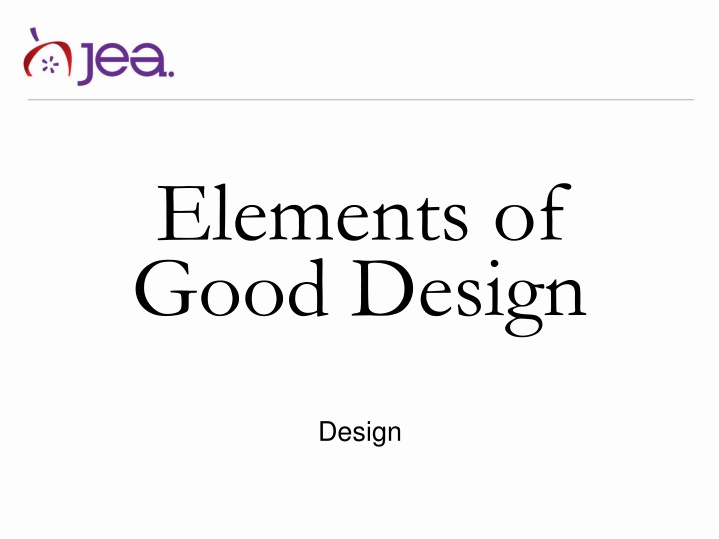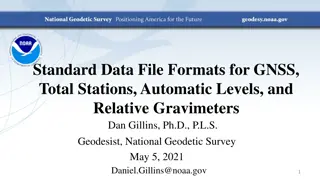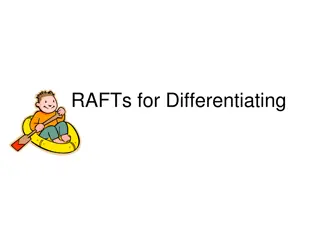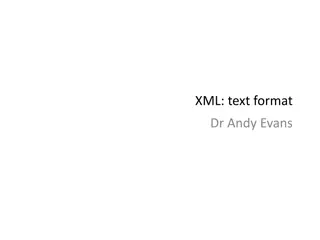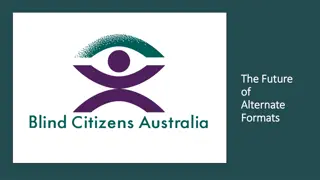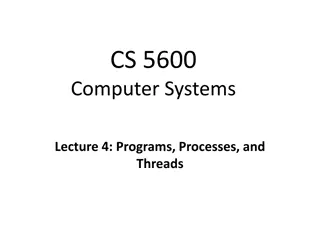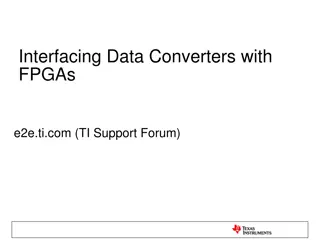Fundamentals of Design: Elements, Principles, and Formats
Understanding the essentials of design such as elements like text, graphics, and white space, principles like dominance, and formats like page layout and measurement units are crucial for creating visually appealing and effective designs. Designers need to grasp concepts like unity, consistency in margins, and utilizing grids for an organized layout to enhance the overall impact of their design work.
Download Presentation

Please find below an Image/Link to download the presentation.
The content on the website is provided AS IS for your information and personal use only. It may not be sold, licensed, or shared on other websites without obtaining consent from the author.If you encounter any issues during the download, it is possible that the publisher has removed the file from their server.
You are allowed to download the files provided on this website for personal or commercial use, subject to the condition that they are used lawfully. All files are the property of their respective owners.
The content on the website is provided AS IS for your information and personal use only. It may not be sold, licensed, or shared on other websites without obtaining consent from the author.
E N D
Presentation Transcript
Elements of Good Design Design
adapted from Robin SawyerFirst Flight High School
The basics of design and layout Every designer works with three basic visual elements Copy or text (words set in type) Graphics or art (photographs, artwork and lines) White space (blank areas on the page)
Formats and grids The physical size of the page is its page format. Most city newspapers (dailies) use the broadsheet format (14 by 22 inches). Student newspapers typically use the tabloid format, which is approximately 11 by 17 inches. The format will, generally, dictate the width of your columns.
Measurement Most graphic designers use the following measurement units: 1 inch = 6 picas 1 pica = 12 points 1 inch = 72 points
Principles of design Dominance Every single page and every double-page spread should have one dominant element. A dominant element is about 2.5 times larger than any other element on the spread. The dominant element serves as the visual entry point to the page. The action in a dominant photo should face into the spread rather than off the page. Without a dominant, the reader s eye will either bounce around from element to element or the reader will skip the page altogether.
flag/nameplate teasers 4-deck headline standing sig byline What s it called? cutline (caption) jumpline pull quote refer (refers to a related story inside) package (sidebar info compliments content of story)
folio main deck with subhead 3-column photo text / copy gutter (white space between columns) rule line 6-column format (standard format) jump head jump line pull quote 4-column format (bastard measure) What s itcalled?
Unity One way to unify a page is by using consistent internal and external margins. o Internal margins: white space between copy and graphics. Usually one pica between elements It differs by publication. For example, one student newspaper uses two picas between unrelated items (two different stories, stories and ads, etc.) and one pica between related items (headline and story, photo and caption).
Unity on double-page spreads Placing a dominant photo or art so that it runs across the center of the two pages helps to link the spread. Another name for a double-page spread is doubletruck.
Unity on double-page spreads Use an eyeline (one pica of horizontal white space that extends across the spread). An eyeline should run at least six picas above or below the horizontal center of the spread.
Unity with type With few exceptions, no more than three different type styles should be used in any publication. (1) One style is chosen for the nameplate and the folios (standing sigs). (2) A second is chosen for the headlines. (3) The third is the text or body type. The only acceptable variation is an occasional special type to achieve a specific purpose or communicate a definite idea for a major feature.
Contrast One of the most important aspects of design is contrast. oUse of opposites in size, shape, weight and color or tone. A design should feature one dominant photo or other graphic contrasted by several smaller photos or graphics with horizontal as well as vertical photos. Different typefaces and the discreet use of screens also create contrast.
Repetition Repetition (rhythm) involves duplicating a color, graphic or typographic element to hold a design together. Yearbooks & Magazines oTemplate designs may use a specific headline design throughout a particular section.
Balance Pages that are balanced can be folded in half vertically, with each half mirroring the other half of the page. This is called symmetrical balance. Informally balanced pages feature weight distributed diagonally. This is preferred. oBig, bold graphic elements are placed toward the center, oWhite space, story copy, headlines and captions are pushed to the outside so that pages do not weigh heavy to one side or the other.
Consistency in newspaper Certain elements of a publication should remain unchanged. Newspaper and newsmagazine staffs should establish the following and keep them the same from issue to issue: oByline style oFolio style oStanding sig style oCaption style oNameplate or flag
Consistency in yearbook Using the same page elements, typography and graphics throughout the theme pages, on the cover, and on the front and back endsheets creates a consistent publication. Consistency within each section is established by using oThe same grid/column structure oHeadline design oCaption design oRepeating sidebar element(s)
Selecting and using type From a design standpoint, the basic component of any story is copy words set in type. When choosing typefaces in general, choose a font that s easy to read for body copy columns of copy for stories. Serif fonts (those with "feet") are usually easier to read in large chunks.
Typography guidelines Consider mixing a serif and sans serif font for your main deck and subheads. Set the leading in body copy at two points higher than your type size. (For example, 10-point body copy would be set with 12-point leading.)
Typography guidelines Choose a font family for headlines that has many different varieties as a way of mixing things up visually on the page. o Roman o Italics o Bold o Bold italics o Semibold o Semibold italics
Modifying type vertically Point size Changing the point size changes the height of the font. The bigger the point size, the taller the type. A headline in 72-point type is one inch tall because there are 12 points in a pica and six picas in an inch(6 x 12 = 72).
Modifying type vertically Leading (pronounced ledding) the vertical spacing between lines of type more specifically, it s the distance from one baseline to the next. Leading must accommodate ascenders (part of letter above standard baseline - b, d, f, k, l, t) and descenders (part of letter below standard baseline - g, y, p j).
The four basic page elements Photo Cutline Headline Text These elements should appear in this order if they are related. NEVER put art between the headline and the start of the story.
Todays headlines are Generally written downstyle (like a sentence without end punctuation) Run left aligned Are usually wide rather than narrow. Use decks optionally, as in this example: Hula hoops have Americans all a-twirl That 60s trend is back, and it s hotter than ever
Types of headlines Kickers These lead into headlines by using a word or phrase to label topics or catch your eye. They re usually smaller than the main head, set in contrasting style or weight. A TREND RETURNS Hula hoops are on a roll
Types of headlines Slammers This two-part head uses a boldface word or phrase to lead into a contrasting main headline. Some papers limit these to special features or jump headlines. Hula hoops: A hot new hit
Types of headlines Raw Wraps Most headlines cover all the text below; this treatment lets text wrap alongside. Hula hoops are circling the nation
Types of headlines Hammers Hammers use a big, bold phrase to catch your eye, then add a lengthier deck below. They re effective, but used primarily for special stories. Hoop-la Hula hoops are sweeping the nation this summer
Types of headlines Tripods This head comes in three parts: a bold word or phrase (often call caps) and two lines of deck squaring off alongside. These are best reserved for special features. They were hot in the 60s, but they re hotter today HULA HOOPS:
Types of headlines Sidesaddle This style lets you park the head beside, rather than above, the story. It s best for squeezing a story preferably one that s boxed into a show horizontal space. Hula hoops are circling the nation this summer
How to size headlines on the page Generally, from largest to smallest as you go down the page. Page One broadsheet o54-72 point for the main story (five or six columns wide) o30-36 for a secondary story that is one or two columns wide o36-42 for the next story down that is four or five columns wide o24-30 for the next one-column head o30-36 for the next three- or four-column headline
Sidebars and infographics A sidebar is any short feature that accompanies a longer story. An infographic (short for informational graphic) blends text and illustrations to convey information visually clarifying the facts with charts, maps or diagrams.
Types of sidebars Fast-fact box Bio box List Glossary Checklist Quiz Q & A Public-opinion poll Quote collection
Types of infographics Fever chart Bar chart Pie chart Table Map Ratings Timeline Step-by-step guide Diagram
General layout guidelines All stories should be shaped like rectangles or squares. Avoid placing any graphic element in the middle of a leg of type. Avoid placing art at the bottom of a leg of type. Text that wraps below a photo should be at least one inch deep. In vertical layouts stack elements: o Photo o Cutline o Headline o Text
General layout guidelines Avoid boxing stories just to keep headlines from butting; it s best to box stories only if they re special or different. Every page should have a dominant piece of art. A well-designed page is usually at least one-third art. Avoid placing a photo or box directly on top of an ad.
General guidelines for text Use italics, boldface, reverse, or any other special effects in small doses. Type smaller than 8- point is often difficult to read. Use small type sparingly, and avoid printing it over a screen. The optimum depth for legs of text is between two and 10 inches. Avoid planning legs of text more than 20 picas wide, or less than 10 picas.
General guidelines for headlines Every story needs a headline. Headlines get smaller as you move down the page. Smaller stories get smaller headlines. 5-10 words is optimum for most headlines. Never allow an art element to come between the headline and the start of a news story. Don t butt headlines. Vary their sizes, styles and the number of lines.
General guidelines for photos Shoot photos of real people doing real things. Directional photos should face the text they accompany. When in doubt, run ONE big photo instead of TWO small ones. When using two or more photos, make one DOMINANT - that is, substantially bigger than any competing photo. Try to vary the shapes and sizes of photos on a page.
General guidelines for cutlines To avoid confusion, run one cutline per photo; each cutline should touch the photo it describes. When cutlines run beside photos, they should be at least six picas wide. When cutlines run below photos, square them off as evenly as possible on both sides of the photo. They should not extend beyond either edge of the photo.
